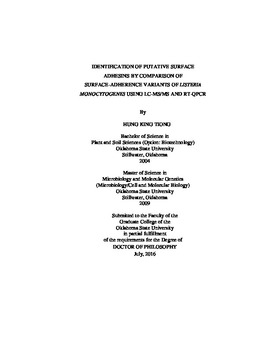| dc.contributor.advisor | Muriana, Peter M. | |
| dc.contributor.author | Tiong, Hung King | |
| dc.date.accessioned | 2017-02-22T22:10:54Z | |
| dc.date.available | 2017-02-22T22:10:54Z | |
| dc.date.issued | 2016-07 | |
| dc.identifier.uri | https://hdl.handle.net/11244/48883 | |
| dc.description.abstract | Listeria monocytogenes is a serious foodborne human pathogen that is known for biofilm formation, but the association of Listeria adherence in food environments and the resulting contamination of RTE products is not well characterized. A total of five methods for extraction of surface proteins from a strain of L. monocytogenes was evaluated for cytoplasmic protein availabilities in protein extracts using a LC-MS/MS (orbitrap) mass spectrometer. The surface protein profiles of weakly and strongly adherent strains of L. monocytogenes from food environments were examined to identify potential surface adhesins. Different subcellular localization tools were utilized for prediction of cytoplasmic protein association with cell envelop. The expression levels of the select genes that possessed higher expression in strongly than weakly adherent L. monocytogenes determined in this study were quantitated using real-time RT-PCR (RT-qPCR). | |
| dc.description.abstract | LC-MS/MS analysis of five surface extracts revealed that one of them showed the least cytoplasmic proteins using Tris-buffered urea extraction of hypotonic-stressed cells (UB-Ghost) among five extraction methods. Protein subcellular localization prediction revealed that many of the isolated cytoplasmic proteins may be 'moonlighting' proteins, suggesting that some cytoplasmic proteins may also moonlightas surface proteins and adhesins. | |
| dc.description.abstract | Comparative analysis of surface proteins recovered from strains of weakly and strongly-adherent L. monocytogenes planktonic and sessile cells using these techniques revealed higher differential protein expression (i.e. >5-fold) in the strongly than in the weakly-adherent strain studied, hence suggesting the presence of other surface proteins acting as adhesins. Relative RT-qPCR analysis of 14 transcripts recovered from L. monocytogenes pre-incubated under planktonic or sessile condition at different temperatures revealed higher gene expression primarily for the strongly than the weakly adherent strain of L. monocytogenes. The analysis also showed higher gene expression for transcript extracts of both cells pre-incubated under conditions of sessile growth and higher temperatures. | |
| dc.description.abstract | Some surface adhesins in L. monocytogenes may be present as cytoplasmic proteins whereby expression is strongly influenced by growth as planktonic or adhered cells. Further studies may identify conditions to better eliminate L. monocytogenes from plant facilities where they can remain adhered and possibly contaminate manufactured foods. | |
| dc.format | application/pdf | |
| dc.language | en_US | |
| dc.rights | Copyright is held by the author who has granted the Oklahoma State University Library the non-exclusive right to share this material in its institutional repository. Contact Digital Library Services at lib-dls@okstate.edu or 405-744-9161 for the permission policy on the use, reproduction or distribution of this material. | |
| dc.title | Identification of putative surface adhesins by comparison of surface-adherence variants of Listeria monocytogenes using LC-MS/MS and RT-qPCR | |
| dc.contributor.committeeMember | Zhang, Glenn | |
| dc.contributor.committeeMember | DeSilva, Udaya | |
| dc.contributor.committeeMember | Fathepure, Babu | |
| osu.filename | Tiong_okstate_0664D_14712.pdf | |
| osu.accesstype | Open Access | |
| dc.type.genre | Dissertation | |
| dc.type.material | Text | |
| thesis.degree.discipline | Food Science | |
| thesis.degree.grantor | Oklahoma State University | |
